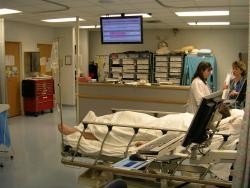
How to Nurture Physician Loyalty For a healthy Top Line

It is common practice that a doctor, especially a specialist refers his patients to multiple hospitals when he/she is affiliated with more than one hospital. This phenomenon is also known as “splitting”.
Splitting can lead to a significant loss in revenue for hospitals who fail to develop strategies to reduce it. It is imperative that hospitals understand the drivers for physicians’ splitting decisions and make adjustments to steer towards tighter, more collaborative relationships between hospitals and physicians.

Sometimes the first real evidence of an issue with physician loyalty can be when a hospital reviews its’ state hospital associations’ utilization data or when physicians report that only a percentage of their surgical cases are done at the hospital as part of a medical staff satisfaction survey.
So when your utilization data and/or your survey results make it clear that physicians are splitting their cases and or referring cases to physicians on the medical staffs of your competitors, it’s important to understand why and act quickly.
When your physicians are splitting their surgical cases between your hospital and that of a competitor, the reasons almost always fall into one of three categories – patient preference, efficiency issues in the OR or relationship issues with the hospitals’ executive leadership team or with other physicians. We will focus on the last two reasons.
Top performing hospitals in OR efficiency tend to be relentless when it comes to identifying barriers to efficiency and removing them when they do find them.
Efficiency Issues in the OR

OR Scheduling: OR scheduling is one of the most frequent reasons given by physicians when asked why they choose to use more than one hospital. OR scheduling represents a unique logistical challenge thanks to variables like physician preference, availability of ancillary staff, and functionality of rooms. If your OR has holes in its’ schedule(s), high rates of add-ons, extended pre-operative length of stay or a perceived need for additional anesthesia or other ancillary services, there is likely a need for an evaluation of scheduling procedures.
The OR schedule can benefit from regular review to insure maximum efficiency – an exercise that has benefits for both physicians and the hospital.
OR Turnover Time: Another challenging aspect of OR management is turnover time. While delays in starts and unexpected complications that may arise in a case can make the scheduling of OR turnover difficult; the failure to do so can result in lost revenue, lost productivity for the surgeon and the hospital and a surgeon who may consider a competitor who has solved this problem. Understand that to a surgeon turnover time means the time between closing one case and opening another. Other definitions may also be technically correct; however, it is most helpful to gear operational improvements toward this definition. The closest analogy is the airline industry: The goal is to minimize the time when the plane is at the gate for unloading, loading, cleaning, replenishing.
Ancillary Services: Another source of frustration for physicians in the OR is in the area of ancillary staff. If physicians have made it clear that long waits for lab and radiology services and/or reports of poor quality are making it difficult for them to complete cases at the hospital, the likely outcome is that the physician will try to find a hospital or surgicenter where these services are more dependable in terms of timeliness and streamlined processes.
Specialty hospitals that offer integrated surgical services from pre-op to post-op convalescence may also represent a competitive threat in your market and can be a serious competitive threat given the ease of practice for physicians.
Relationship Issues with the Hospitals’ Executive Leadership Team or with Other Physicians.

Supporting Staff: Similarly, we have heard repeatedly from physicians that the supporting staff, e.g., nurses, residents, technicians are not meeting their needs. If this is also the case at your hospital, now is the time for an action plan to address these issues. The Studer Group’s recommendation to use physician preference cards is one of the best practices in ORs and on nursing units. This helps to insure that the OR staff, including nursing, knows each physicians’ preferences including room needs and equipment and supply preferences. The creation of the preference cards has the added benefit of helping physicians feel as if they have been heard by the hospital’s leadership team. The cards save time and minimize misunderstanding between physicians and the supporting staff.
Leadership: The relationship between the C-Suite and the medical staff is probably the most reliable predictor of the degree to which a hospital will see splitting. The predictors of a strong relationships between the hospital and its medical staff tend to be “common sense”, but the degree to which hospitals have developed and executed a successful action plan to address the predictors/drivers is the big differentiator in physician loyalty. Typically, an action plan for this area should include strategies to address communication issues, physician input into decision-making and equipment and supply needs.
Referrals: Lastly, the practice of medicine is very different than it was fifty years ago. If your consumer or medical staff data make it clear that physicians are splitting their cases or that patients are using competing hospitals for services that are provided at your hospital, be sure to help physicians understand the scope of services and specialists available. It seems almost too simple to be true, but the size of some hospitals and their medical staffs make it difficult to insure that physicians are referring to other physicians on the same medical staff.
Hospital leaders can help their medical staff by going back to the old fashioned concept of a medical directory to highlight the availability of specialists. Medical staff meetings and department meetings can also serve as a great means of introducing your medical staff to one another and facilitating more referrals. Regular “Physician Mixers” such as breakfast receptions, dinners or cocktail parties really help. The business development department may also benefit and should carefully track the attendance for the functions and follow up with analysis for its effectiveness.
There are definitely other reasons that impact physicians’ choice of hospitals for their cases. Given the direct correlation of “Splitting” (cases) to a hospital’s revenue, it is worth the investment to conduct regular surveys along with your utilization data to minimize the impact from this issue.
